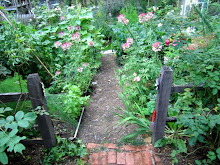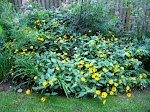It's amazing how kids pick up vocabulary. Some friends and I were remarking how our kids' vocabularies have expanded through reading, but since some of the words they are learning are more often read than heard, there are gaps in their pronunciation. This got me to thinking about my botanical Latin. I know most of the Latin names for the plants I grow, but mostly through reading countless books and articles about gardening. My pronunciation of some of the words is more than iffy.
As I was thinking about this the new listing of courses offered at the The New York Botanical Garden (NYBG) arrived in the mail (http://www.nybg.org/edu/cont_ed_cat.php). This September, they are offering a four week course on botanical Latin for professional and amateur gardeners. This course is aimed at teaching pronunciation and the root meaning of the words.
If you can't make it to NYBG, I also found a wonderful feature of the Fine Gardening website (http://www.taunton.com/finegardening/pguide/pronunciation-guide-to-botanical-latin.aspx) which makes available a pronunciation guide for plants included in recent issues of the magazine. This was the only site I found that says the words for you. So, like our children, I'll be brushing up on my pronunciation too.
Welcome to Heirloom Gardener
Thursday, February 28, 2008
Pronouncing Latin Plant Names
Posted by
Julia Erickson
at
7:40 PM
7
comments
![]()
![]()
Labels: Online Gardening Resources
Monday, February 25, 2008
Volunteers: Hardy Annual and Biennial Self Seeders
Hardy volunteers are a welcome gift from the garden. I have several reseeding annuals and biennials which each year enrich the garden. These plants which spring up where they please provide necessary filler and continuity within the borders. The advantage of volunteers is they weave themselves naturally into the garden. By doing so they hold the other plants together and give it a more relaxed feel. Also, they sometimes pop up where I would not have thought of planting them or could not have planted them. Reseeders also fill any holes in the plantings offering a sense of abundance. I have two types of volunteers: accent plants and unifiers.
 Amaranthus 'Hopi' is a very tall, red stemmed plant which I grow in the Cutting Garden, Egg Garden, and Long Border (it is pictured here between the Egg Garden and the Front Border). I bought Hopi from Annie's Annuals three years ago. It is a generous self seeder which requires thinning out of the seedlings in the spring since I only want about five or six plants. The birds love the seeds so I usually don't worry about too many seedlings. I also cut off some of the flowers as the seeds mature to keep for fall decorations.
Amaranthus 'Hopi' is a very tall, red stemmed plant which I grow in the Cutting Garden, Egg Garden, and Long Border (it is pictured here between the Egg Garden and the Front Border). I bought Hopi from Annie's Annuals three years ago. It is a generous self seeder which requires thinning out of the seedlings in the spring since I only want about five or six plants. The birds love the seeds so I usually don't worry about too many seedlings. I also cut off some of the flowers as the seeds mature to keep for fall decorations. When the amaranthus is young, I transplant some into containers or to other spots where I want them to grow. I keep more in the cutting garden for arrangements and to be dug up at a later date to fill in any holes which develop.
Sunflowers are always welcome. Due to the birds, I only get a few of these, but they are greatly appreciated.
 Inspired by Mottisfont Abbey (http://www.nationaltrust.org.uk/main/w-vh/w-visits/w-findaplace/w-mottisfont/), I have white foxglove in the Rose Garden. Most of the seedlings which I don't thin out grow in situ, but others are moved to the Cutting Garden. I try to keep the foxglove in the Rose Garden white, so any which bloom non-white are cut for arrangements. If you don't like having the spent flower stem left up, it works quite well to cut the stalk and lay it on the ground. I find that once the upper most flowers have bloomed the seeds from the bottom ones are mature. Cutting the stems also has the added advantage of stimulating the plant to produce more flowering side shoots.
Inspired by Mottisfont Abbey (http://www.nationaltrust.org.uk/main/w-vh/w-visits/w-findaplace/w-mottisfont/), I have white foxglove in the Rose Garden. Most of the seedlings which I don't thin out grow in situ, but others are moved to the Cutting Garden. I try to keep the foxglove in the Rose Garden white, so any which bloom non-white are cut for arrangements. If you don't like having the spent flower stem left up, it works quite well to cut the stalk and lay it on the ground. I find that once the upper most flowers have bloomed the seeds from the bottom ones are mature. Cutting the stems also has the added advantage of stimulating the plant to produce more flowering side shoots. Sweet William, a biennial, is another heirloom plant which is extremely easy to grow, but often overlooked (pictured here under the wisteria). The flowers of the older varieties like Holborn's Glory are fragrant and make a nice edging in the front of a border. I have these in the Cutting Garden and Long Border.
Sweet William, a biennial, is another heirloom plant which is extremely easy to grow, but often overlooked (pictured here under the wisteria). The flowers of the older varieties like Holborn's Glory are fragrant and make a nice edging in the front of a border. I have these in the Cutting Garden and Long Border. Queen Anne's Lace is confined to the Cutting Garden as it is great mixed with other cut flowers. It took me several years to get it to grow which leads me to believe that the freshness of the seed makes a great difference in establishing it. Since then, I have had no problems keeping it. With fresh seed it reseeds quite a lot; after all, it is a weed to many. To prevent it from going beyond its welcome, I do not allow it into other areas of the garden; I cut a lot of it; and I thin it out when I have too much.
Queen Anne's Lace is confined to the Cutting Garden as it is great mixed with other cut flowers. It took me several years to get it to grow which leads me to believe that the freshness of the seed makes a great difference in establishing it. Since then, I have had no problems keeping it. With fresh seed it reseeds quite a lot; after all, it is a weed to many. To prevent it from going beyond its welcome, I do not allow it into other areas of the garden; I cut a lot of it; and I thin it out when I have too much. Spider flowers (cleome) are big and are sometimes hard to plant in the garden without them looking like stiff soldiers. But once spider flowers are allowed to self seed, it transforms them. They look very natural growing through other plants and often to different heights depending on where they are. They also have a range of color. In the front of Goldberry Hill, I only allow violet ones. In the Egg Garden, I try to keep more white than pink. In the Children's Garden (pictured), they are mostly pink because my daughter loves pink. Also, as the first plants become leggy, plants from seed which germinated later reach up to cover up the old bare stalks.
Spider flowers (cleome) are big and are sometimes hard to plant in the garden without them looking like stiff soldiers. But once spider flowers are allowed to self seed, it transforms them. They look very natural growing through other plants and often to different heights depending on where they are. They also have a range of color. In the front of Goldberry Hill, I only allow violet ones. In the Egg Garden, I try to keep more white than pink. In the Children's Garden (pictured), they are mostly pink because my daughter loves pink. Also, as the first plants become leggy, plants from seed which germinated later reach up to cover up the old bare stalks.
Posted by
Julia Erickson
at
12:45 AM
12
comments
![]()
![]()
Labels: Propagation and Seeds, Self Seeders
Saturday, February 23, 2008
Forced Branches: Quince, Crabapple, Willow, Ceris, Dogwood, and Forsythia

Quince are easy to force and grow. The flowers are very delicate and are lovely against the mostly bare branches. The shrubs are vigorous and won't miss anything you cut. The only caveat is that they should be planted in an out of the way spot because they tend to lose most of their leaves by midsummer and are a bit thorny. Quinces will grow in full sun or part shade with equal success.
Crabapple (pictured above) to my surprise has been extremely easy to force. I brought some into the house from the Egg Garden a few weeks ago with the intention of enjoying the fruit that remained. In about a week, the buds began to swell; then the branches leafed out; and now, they are just beginning to break into bloom.
All kinds of willow are super easy. Ones with large catkins are wonderful to look at, but also are a treat to touch. But other willows which are grown more for their leaf like Salix 'Flamingo' are fun to watch leaf out and root at the same time.
Ceris 'Forest Pansy" is beautiful when forced and pruning it helps to keep it small enough for the front border. The dainty little flowers can also be better appreciated when viewed up close in a vase. I do not have other redbuds in my garden. I would love to see if the redbuds which produce flowers all along their stems before they leaf out would force also.
The red twig dogwoods make great displays all winter. The dark red stems are beautiful especially when contrasted with the new lime green leaves. The yellow stemmed ones would work well too and would be more subtle.
Posted by
Julia Erickson
at
11:10 AM
6
comments
![]()
![]()
Labels: Cut and Forced Flowers
Thursday, February 21, 2008
Telegraph.co.uk - 'Annabelle' hydrangea: How to grow

I was walking around my garden this weekend and I couldn't resist taking yet another picture of my Annabelle hydrangeas. As I wrote in a prior post, my Annabelle hydrangeas--with their dried blossoms--are a highlight of my winter garden (http://heirloomgardener.blogspot.com/2007/12/annabelle-hydrangea-in-winter.html).
This past week, Telegraph.co.uk--the online version of the Telegraph in London--wrote an article praising Annabelle hydrangeas and giving advice on how to grow them. Val Bourne writes:
"The cool white Hydrangea arborescens 'Annabelle' produces one of the most magical of all winter seed heads. After the flowers have faded and fallen, a skeleton of fine tracery remains to catch the frost and low winter sunshine. So this is one hydrangea that deserves a prominent place in every garden, somewhere it can shine in three seasons - summer, autumn and winter."
For the full article, click here: http://www.telegraph.co.uk/gardening/main.jhtml?xml=/gardening/2008/02/08/garden-hydrangea-grow108.xml.
Posted by
Julia Erickson
at
8:51 PM
3
comments
![]()
![]()
Labels: Hydrangeas, Seed Heads, Shrubs, Winter Garden
Wednesday, February 20, 2008
How to Prune Roses, Part I: An Introduction to One Gardener's Observations on Pruning Her 150+ Roses

Rose pruning is a year-round job, but a significant part of it happens now. In my garden, I have about 150 roses representing 95 varieties. About half of my roses are once blooming species and old European roses. Most of the other half is a mix of Rugosas, Portlands, Hybrid Perpetuals, Chinas, David Austin roses, Bourbons, and Ramblers. I also have a few Noisettes that are hardy to zone 6 and modern shrubs.
The first step to all pruning is gathering your tools: Felco hand pruners, loppers, glue, gloves, and a bucket to collect the prunings. If you haven't sharpened and cleaned your tools already, it's time to do so. There are lots of simple sharpeners out there and sharp tools make pruning easier and are better for the rose. For older shrubs with very thick canes or to pull out material without thrusting your hand into the middle of the bush, loppers are handy.
When I prune roses, I sometimes start barehanded, but I always regret it and end up going back to the house for gloves. The thing I don't like about most gloves is that to be thick enough to not let the thorns in, the gloves restrict the movement of your hand. Last year, however, I bought a pair of rose pruning gloves from West County Glove that are wonderful. They go up to my elbow and allow very free movement of my hands and wrist.
I also get a kneeler because most roses require you to get down onto the ground to have a good look and them. Lastly, I bring out a bucket or large garbage can to hold all my prunings to make clean up easier. My favorite buckets are Tubtrugs.
For "How to Prune Roses, Part II: Old Rose Pruning Secrets" click here:
http://heirloomgardener.blogspot.com/2008/03/how-to-prune-roses-part-ii-old-rose.html.
For "How to Prune Roses, Part III: Why Prune?" click here:
http://heirloomgardener.blogspot.com/2008/03/how-to-prune-roses-part-iii-why-prune.html.
Posted by
Julia Erickson
at
4:55 PM
4
comments
![]()
![]()
Labels: Books and Movies, Gardening Tools and Structures, Pruning and Maintenance, Roses
Sunday, February 17, 2008
Garden Blog Highlights
For some new and inspiring winter garden photographs, check out Country Gardener (http://countrygardener.blogspot.com/2008/02/ice-storm-then-snow-storm.html) and View from Federal Twist (http://federaltwist.blogspot.com/2008/02/my-wet-prairie-in-february-turning.html).
For those of you who love lists of plants, Gardening Tips 'N' Ideas notes "Val Bourne from the UK's Telegraph has boldly gone where no other garden journalist would dare tread - creating her list of the Top 100 Plants Every Garden Should Have" (http://www.gardeningtipsnideas.com/2008/02/100_plants_every_garden_should_have.html).
For fans of living sculptures, Rurality has compiled some amusing photos of mud men and moss maids (http://rurality.blogspot.com/2008/02/of-mud-men-and-moss-maids.html) and Ellis Hollow displays a whimsical cow (http://www.remarc.com/craig/?p=339).
Lastly, for those of you who like to knit when you can't garden, You Grow Girl has a great post on knit vegetables (http://www.yougrowgirl.com/thedirt/2008/01/31/knit-a-beet/).
Posted by
Julia Erickson
at
10:24 PM
5
comments
![]()
![]()
Labels: Gardening Blogs
Dried Annabelle Hydrangeas
 I have several Annabelle hydrangeas on Goldberry Hill. During the summer, their large white mopheads look great both in the garden and brought indoors as cut flowers. As they age, they turn green and then brown. This summer, my friend P cut some of them when they were green, dried them at her home, and gave them to me as a present in the early winter. As you can see, they have retained their attractive green color.
I have several Annabelle hydrangeas on Goldberry Hill. During the summer, their large white mopheads look great both in the garden and brought indoors as cut flowers. As they age, they turn green and then brown. This summer, my friend P cut some of them when they were green, dried them at her home, and gave them to me as a present in the early winter. As you can see, they have retained their attractive green color. For a prior post about their contribution to the garden in winter, click here: http://heirloomgardener.blogspot.com/2007/12/annabelle-hydrangea-in-winter.html.
For a prior post about their contribution to the garden in winter, click here: http://heirloomgardener.blogspot.com/2007/12/annabelle-hydrangea-in-winter.html.
Posted by
Julia Erickson
at
1:41 PM
5
comments
![]()
![]()
Labels: Hydrangeas, Shrubs
Saturday, February 16, 2008
How to Prune Pee Gee Hydrangeas and Wisteria: Before Spring Growth Resumes
 February is the time in my garden to prune the pee gee hydrangeas and the wisteria. I have two pee gee hydrangea standards: one along my front walk (pictured before and after pruning) in the Front Border and another along the fence in the back garden. I do this primarily because space is limited where it's growing and, secondly, by pruning it I get more blooms (for a picture of the blooms, click here: http://heirloomgardener.blogspot.com/2008/01/front-border-in-summer-plan-for-new.html).
February is the time in my garden to prune the pee gee hydrangeas and the wisteria. I have two pee gee hydrangea standards: one along my front walk (pictured before and after pruning) in the Front Border and another along the fence in the back garden. I do this primarily because space is limited where it's growing and, secondly, by pruning it I get more blooms (for a picture of the blooms, click here: http://heirloomgardener.blogspot.com/2008/01/front-border-in-summer-plan-for-new.html).
 The best time to do this is when the plant is dormant, before the buds begin to swell. If you wait until spring growth resumes, you risk removing this year's flowers. Pruning can be done in the early winter, but you will miss the lovely dried blooms during the winter. Every year I prune away the previous year's growth for the one along the walkway. I also take out any twiggy branches that have died back during the winter. For the other which has more space allotted to it, I trim it back to shape it and remove spindly growth.
The best time to do this is when the plant is dormant, before the buds begin to swell. If you wait until spring growth resumes, you risk removing this year's flowers. Pruning can be done in the early winter, but you will miss the lovely dried blooms during the winter. Every year I prune away the previous year's growth for the one along the walkway. I also take out any twiggy branches that have died back during the winter. For the other which has more space allotted to it, I trim it back to shape it and remove spindly growth.  The wisteria I have is grown as a tree, but the pruning for it is the same as it would be for one grown against a wall. Each branch is cut back to the third or forth bud and any wispy growth is removed. The wisteria is good now until mid summer at which point it will need pruning again.
The wisteria I have is grown as a tree, but the pruning for it is the same as it would be for one grown against a wall. Each branch is cut back to the third or forth bud and any wispy growth is removed. The wisteria is good now until mid summer at which point it will need pruning again.  Related post: How and Why to Prune Hydrangeas
Related post: How and Why to Prune Hydrangeas
Posted by
Julia Erickson
at
11:18 PM
6
comments
![]()
![]()
Labels: Front Border, Hydrangeas, Pruning and Maintenance, Shrubs
Friday, February 15, 2008
Witch Hazel: Winter's Cheerleader, Yelling for Spring
As a follow-up to my prior post (http://heirloomgardener.blogspot.com/2007/12/common-witchhazel-blooming-in-december.html), this week's "In the Garden" section of the New York Times featured an article singing the praises of witch hazels, provides useful information about different cultivars, and lists three nurseries that carry a broad selection of them: Fairweather Gardens in Greenwich, NJ; RareFind Nursery in Jackson, NJ; and Broken Arrow Nursery in Hamden, CT.
Anne Raver writes: "Sunny, warm days in midwinter always send me in search of fragrant witch hazels, those graceful shrubs that unfurl their crinkled, confetti-like flowers from January to March." For the full article, including some great photographs by Andrea Mohin, click here: http://www.nytimes.com/2008/02/14/garden/14garden.html?ex=1360731600&en=cf0cacc8f115ae37&ei=5124&partner=permalink&exprod=permalink
Posted by
Julia Erickson
at
8:08 PM
6
comments
![]()
![]()
Wednesday, February 13, 2008
Great Blog Posts About Piet Oudolf
Yvonne Cunnington at Country Gardener has a beautiful picture of her Piet Oudolf Inspired Garden. She writes: "The lack of fussiness, tossing out high maintenance deadheading and staking, combining grasses with naturalistic perennials - these are all the qualities that drew me to his style, which happens to be tailor-made for country gardens." For the full post, click here: http://countrygardener.blogspot.com/2008/02/more-piet-oudolf.html
Yolanda Elizabet at Bliss has pictures of Piet Oudolf's private garden. She writes: "Last week I went to Piet Oudolf to look at his nursery and private garden. I had paid him a visit before, last October, but that was during the Grass Days (held annually) when several other nurseries sell their stuff at Piet's place too." For the full post, click here: http://blissyo-elgarden.blogspot.com/2007/07/piet-oudolfs-private-garden.html
James Golden at View from Federal Twist writes of Piet Oudolf's next New York City project, the Highline. He writes: "The Highline, an abandoned elevated rail line on the West Side of Manhattan, is being converted into a linear park and trail. For the first time in New York City, this innovative park will introduce Piet Oudolf's work on a large scale. While his plantings for the Memorial Gardens in Battery Park are a successful and attractive feature of Manhattan's southern tip, the Highline is a much more ambitious and challenging project that promises to attract widespread attention." For the full post, click here: http://federaltwist.blogspot.com/2006/10/highline.html
Posted by
Julia Erickson
at
9:17 PM
4
comments
![]()
![]()
Labels: Gardening Blogs, Piet Oudolf
Tuesday, February 12, 2008
Inspiration for the Long Border: American Prairie Plants in Battery Park, Designed by Piet Oudolf
I love the plants of the American prairie. The simple forms are beautiful. They are undemanding, attract tons of butterflies, flower over a long period of time, and make me feel connected to the land. Unfortunately, I don't have the setting and environment where I could create a meadow garden.
In the Long Border, I have tried to incorporate many of these plants--echinacea, black eyed susans, phlox, butterfly weed, goldenrod, joe pye weed, asters, liatris, veronicastrum, monarda, baptisia, rattlesnake master--into my planting.
My inspiration for the Long Border came from a trip I took to the gardens of Battery Park in lower Manhattan. These American prairie plants compose a large part of the palette used by Piet Oudolf, the Dutch garden designer of the park. Below are some of the photographs I took on my visit. The first picture shows purple coneflower and mountain mint in the foreground, backed by monarda, veronicastrum, joe pye weed, and miscanthus.
The first picture shows purple coneflower and mountain mint in the foreground, backed by monarda, veronicastrum, joe pye weed, and miscanthus. The second photo shows baptisia (not in flower), monarda, and daylilies with a mass of amsonia in the back.
The second photo shows baptisia (not in flower), monarda, and daylilies with a mass of amsonia in the back.  Photo three shows veronicastum, Russian sage, yarrrow, rattlesnake master, and alliums.
Photo three shows veronicastum, Russian sage, yarrrow, rattlesnake master, and alliums. The fourth photo shows liatris and switch grass.
The fourth photo shows liatris and switch grass. 
The fifth photo includes purple coneflower, switch grass, astilbe, and oregano.
For pictures of the Long Border, click here: http://heirloomgardener.blogspot.com/2008/01/garden-for-late-summer-long-border.html
For my prior post on Piet Oudolf, click here: http://heirloomgardener.blogspot.com/2008/02/winter-garden-inspiration-piet-oudulf.html
Posted by
Julia Erickson
at
9:18 PM
5
comments
![]()
![]()
Labels: Botanical Gardens, Mixed Borders, Piet Oudolf
Sunday, February 10, 2008
Shakespeare: A February Face, So Full of Frost, Of Storm And Cloudiness

I woke up early this morning before my husband and children and took a walk around the garden. It was cold and there were only a few signs of spring and almost nothing worthwhile to photograph.
After church, we were sitting down for lunch looking out the windows to the west to this view. Today, with the movement of the sky and the trees, it was particularly beautiful.
Later, we were drawing with the children and this image came back to my mind's eye when I was looking through a book of Van Gogh's landscapes, especially the starkness of the trees and the movement of the sky. One of my favorites is his drawing Avenue of Willows with Shepherd and Peasant Woman, 1884.
Regarding this long month for gardeners in the Nothern states, Carolyn over at Sweet Home and Garden Chicago has a great quote from Shakespeare's Much Ado About Nothing: "Why what's the matter that you have such a February face, so full of frost, of storm and cloudiness?"
For Carolyn's full post, click here: http://sweethomeandgardenchicago.blogspot.com/2008/02/garden-bloggers-muse-day-feb-1.html
Posted by
Julia Erickson
at
6:28 PM
5
comments
![]()
![]()
Labels: Gardening Blogs, Winter Garden
Wednesday, February 06, 2008
Garden Color: Inspiration from Chanticleer in Wayne, Pennsylvania
 Chanticleer, in Wayne, Pennsylvania, is one of my greatest sources of inspiration as a gardener. It describes itself as 'America's pleasure garden' and that it is. I love Chanticleer because you can tell the staff loves plants and loves to play with them in creative combinations and venues. Everything is done to please and exite the senses.
Chanticleer, in Wayne, Pennsylvania, is one of my greatest sources of inspiration as a gardener. It describes itself as 'America's pleasure garden' and that it is. I love Chanticleer because you can tell the staff loves plants and loves to play with them in creative combinations and venues. Everything is done to please and exite the senses.
 Color at Chanticleer is as much about flowers as it is about foliage. The combination of various leaf colors, textures, and shapes makes the garden interesting without any thought to flowers.
Color at Chanticleer is as much about flowers as it is about foliage. The combination of various leaf colors, textures, and shapes makes the garden interesting without any thought to flowers. Purple leafed plants run as a theme through Chanticleer. I love how dark leaves interact with light and add a deep rich beauty which soothes the mind rather than excites.
Purple leafed plants run as a theme through Chanticleer. I love how dark leaves interact with light and add a deep rich beauty which soothes the mind rather than excites. Over the last several years of viewing Chanticleer, I have added two smokebushes (Cotinus 'Grace' and 'Royal Purple'), Rose glauca, purple phormiums, dark leafed clematis like 'Freda', amaranthus 'Hopi Red Dye' to my garden. The dark color relieves the green and really brings out any silver toned plants nearby. Also, the purple foliage looks great in floral arrangements.
Over the last several years of viewing Chanticleer, I have added two smokebushes (Cotinus 'Grace' and 'Royal Purple'), Rose glauca, purple phormiums, dark leafed clematis like 'Freda', amaranthus 'Hopi Red Dye' to my garden. The dark color relieves the green and really brings out any silver toned plants nearby. Also, the purple foliage looks great in floral arrangements. One of my favorite quotations from Christopher Lloyd as it regards planting and border design is that "you should never have to explain what you were trying to do." At Chanticleer, this rings true. All the plantings are dense, rich, and full. The feeling of abundance surrounds you. There is rarely one of anything. Instead, it's large swaths of poppies set against orange wallflowers.
One of my favorite quotations from Christopher Lloyd as it regards planting and border design is that "you should never have to explain what you were trying to do." At Chanticleer, this rings true. All the plantings are dense, rich, and full. The feeling of abundance surrounds you. There is rarely one of anything. Instead, it's large swaths of poppies set against orange wallflowers. My garden is my small piece of Eden where I can experience this. This year I want to do a combination of yellow anthemis and orange butterfly weed. I know from Chanticleer I'll want to plant more than I think of both.
My garden is my small piece of Eden where I can experience this. This year I want to do a combination of yellow anthemis and orange butterfly weed. I know from Chanticleer I'll want to plant more than I think of both.  For more information about Chanticleer, click here: http://www.chanticleergarden.org/
For more information about Chanticleer, click here: http://www.chanticleergarden.org/  This post was inspired by the "Garden Bloggers' Design Workshop - Colors in the Garden" at one of my favorite gardening blogs, Gardening Gone Wild: http://www.gardeninggonewild.com/?p=698
This post was inspired by the "Garden Bloggers' Design Workshop - Colors in the Garden" at one of my favorite gardening blogs, Gardening Gone Wild: http://www.gardeninggonewild.com/?p=698
Posted by
Julia Erickson
at
8:15 PM
7
comments
![]()
![]()
Labels: Botanical Gardens, Garden Bloggers' Design Workshop, Garden Planning, Poppies
Sunday, February 03, 2008
Twelve Months of Garden Color in New Jersey (Zone 6b)
As it relates to color in the garden, one of my goals is to create year-round interest. Looking through my pictures, the year starts with whites and yellows; the middle months have a full range of of bright colors; and the year ends with the deep colors of berries. Here is a brief overview of these colors with one picture for each month of the year.
This post was inspired by the "Garden Bloggers' Design Workshop - Colors in the Garden" at one of my favorite gardening blogs, Gardening Gone Wild: http://www.gardeninggonewild.com/?p=698 January in northern New Jersey (zone 6b) is a hard month to find any color in the garden. Fortunately, whenever the weather warms up into the forties, the forsythia start to show off some of their blooms. Of course, when it gets cold again, they hide themselves away until it warms up in earnest. This is the time when I start to cut the branches off and bring them indoors to force--my favorite thing to do with forsythia.
January in northern New Jersey (zone 6b) is a hard month to find any color in the garden. Fortunately, whenever the weather warms up into the forties, the forsythia start to show off some of their blooms. Of course, when it gets cold again, they hide themselves away until it warms up in earnest. This is the time when I start to cut the branches off and bring them indoors to force--my favorite thing to do with forsythia.
 February is the month for snowdrops. I have snowdrops in the Cutting Garden and, last fall, planted more in the Walled Garden. These small flowers are so cute and the first real sign that spring is coming. Given their size, you really can't plant too many of them--think hundreds. Since I like to plant a lot, I buy my snowdrops wholesale from Van Engelen. Once they come up, I cut small bunches for vases. Pests do not eat these bulbs.
February is the month for snowdrops. I have snowdrops in the Cutting Garden and, last fall, planted more in the Walled Garden. These small flowers are so cute and the first real sign that spring is coming. Given their size, you really can't plant too many of them--think hundreds. Since I like to plant a lot, I buy my snowdrops wholesale from Van Engelen. Once they come up, I cut small bunches for vases. Pests do not eat these bulbs. The March bulb show begins with winter aconite. It is another small bulb that I planted under Prunus 'Forest Pansy' in my front border. It took me a couple of years for me to get these established. I was most successful with bulbs from Old House Gardens. I think the difference was that these bulbs dry out very easily and Old House Gardens coats the bulbs in a horticultural wax to prevent this. If you know someone with an established clump, it's best to beg a few in the green and replant them immediately in your garden. Pests do not eat these bulbs.
The March bulb show begins with winter aconite. It is another small bulb that I planted under Prunus 'Forest Pansy' in my front border. It took me a couple of years for me to get these established. I was most successful with bulbs from Old House Gardens. I think the difference was that these bulbs dry out very easily and Old House Gardens coats the bulbs in a horticultural wax to prevent this. If you know someone with an established clump, it's best to beg a few in the green and replant them immediately in your garden. Pests do not eat these bulbs. April, of course, is the month for daffodils. I plant hundreds of daffodils all over the garden. I plant all sizes and colors, but am particularly fond of the white daffodils. The earliest actually start to bloom at the end of March and they last through April into May. Pictured here is an old heirloom Thalia.
April, of course, is the month for daffodils. I plant hundreds of daffodils all over the garden. I plant all sizes and colors, but am particularly fond of the white daffodils. The earliest actually start to bloom at the end of March and they last through April into May. Pictured here is an old heirloom Thalia. May is one of my favorite months in the garden as tulips explode everywhere. Last year, my combination was inspired by the Granny's Garden collection from Old House Gardens. I planted a mix of the following tulips, most of which are older varieties: Cum Laude, Glowing Pink, Kingsblood, Maureen, Queen of the Night, Dillenborg, Mrs. John Scheepers, Colour Cardinal, Princess Irene, and Ballerina.
May is one of my favorite months in the garden as tulips explode everywhere. Last year, my combination was inspired by the Granny's Garden collection from Old House Gardens. I planted a mix of the following tulips, most of which are older varieties: Cum Laude, Glowing Pink, Kingsblood, Maureen, Queen of the Night, Dillenborg, Mrs. John Scheepers, Colour Cardinal, Princess Irene, and Ballerina.
 July is when the plants from and reminescent of the American prairie take over. Purple coneflower, the many rudbeckias, joe pye weed, heleniums, helianthus, phlox, milkweed, monarda, erygium, echinops, and shasta daisies all begin their bloom. These plants, despite the heat and humidity of summer, keep going and going while attracting many birds, hummers, and butterflies to the garden. By mixing these with grasses, you have color, movement, and beauty that will carry you well into September.
July is when the plants from and reminescent of the American prairie take over. Purple coneflower, the many rudbeckias, joe pye weed, heleniums, helianthus, phlox, milkweed, monarda, erygium, echinops, and shasta daisies all begin their bloom. These plants, despite the heat and humidity of summer, keep going and going while attracting many birds, hummers, and butterflies to the garden. By mixing these with grasses, you have color, movement, and beauty that will carry you well into September. One of my daughters is in love with hibiscus and has been reminding me I haven't put a picture of her hibiscus on my blog yet. In August, the huge tropical looking flowers garner lots of attention. The flowers are great floated in a vase and keep coming over a long period of time. Also, the seed pods of the hibiscus are quite beautiful afterward.
One of my daughters is in love with hibiscus and has been reminding me I haven't put a picture of her hibiscus on my blog yet. In August, the huge tropical looking flowers garner lots of attention. The flowers are great floated in a vase and keep coming over a long period of time. Also, the seed pods of the hibiscus are quite beautiful afterward. September is part of summer in my book. The garden is still in full swing with no sign of winding down. By the end of the month, however, the Japanese anemone 'Queen Charlotte' is beginning to bloom, signaling the very beginning of fall.
September is part of summer in my book. The garden is still in full swing with no sign of winding down. By the end of the month, however, the Japanese anemone 'Queen Charlotte' is beginning to bloom, signaling the very beginning of fall. 
 The butterfly weed pictured here was a welcome volunteer from a clump of Mexican milkweed I planted in 2006. I did not expect it to reseed for me given that its grown mainly in zone 8 and warmer. But the seedling did come and were enjoyed by many monarch catepillars. The plants came into bloom very late in the season. They, however, made it through many light frosts and only died well into November when we had a hard frost.
The butterfly weed pictured here was a welcome volunteer from a clump of Mexican milkweed I planted in 2006. I did not expect it to reseed for me given that its grown mainly in zone 8 and warmer. But the seedling did come and were enjoyed by many monarch catepillars. The plants came into bloom very late in the season. They, however, made it through many light frosts and only died well into November when we had a hard frost.
Posted by
Julia Erickson
at
4:39 PM
17
comments
![]()
![]()
Labels: Autumn Garden, Garden Bloggers' Design Workshop, New Jersey / Local Interest, Spring Garden, Summer Garden, Winter Garden
Saturday, February 02, 2008
Winter Garden Highlight: Lace Cap Hydrangea on Goldberry Hill
As I've written about in some of my prior posts, I have been trying to improve the appearance of my garden in winter. Part of this improvement includes appreciating the beauty that is already there, such as the large, mature hydrangea at the top of Goldberry Hill. The form and color of the bare stems have a beauty all their own.

Posted by
Julia Erickson
at
12:29 PM
4
comments
![]()
![]()
Labels: Hydrangeas, Shrubs, Winter Garden
Japanese Beautyberry (Unexpected) Propagation
As a follow-up to my prior post about Japanese Beautyberry, I have an unexpected surprise to share with all of you. The Japanese Beautyberry that I cut back in November and put in a vase of water started rooting and sending up new shoots, as you can see in the pictures below. I should replant them now in some soil let them develop better roots inside before planting them outside in the spring.
For the original post, click here: http://heirloomgardener.blogspot.com/2007/12/japanese-beautyberry.html

Posted by
Julia Erickson
at
12:19 PM
6
comments
![]()
![]()
Labels: Cut and Forced Flowers, Japanese Beautyberry, Propagation and Seeds, Shrubs
Winter Garden Inspiration: Piet Oudulf
I have been working on making my garden look more attractive during the long winter months. In this week's Home & Garden section of the New York Times, they give a peak into famous Dutch gardener Piet Oudolf's personal garden in an article entitled "A Landscape in Winter, Dying Heroically." His personal garden is only one acre, and it is an inspiration--even in winter. For the full article and slide show, click here:
http://www.nytimes.com/2008/01/31/garden/31piet.html?ex=1359522000&en=9170d4bed2c36a64&ei=5124&partner=permalink&exprod=permalink
Posted by
Julia Erickson
at
12:02 PM
2
comments
![]()
![]()
Labels: Piet Oudolf, Winter Garden
Search Heirloom Gardener
Labels
- About Blogging
- Annuals/Biennials and Perennials
- Autumn Garden
- Books and Movies
- Botanical Gardens
- Bulbs and Tubers
- Children's Garden
- Chrysanthemum
- Clematis
- Container Gardening
- Crocus tommasiniasus roseus
- Cut and Forced Flowers
- Cutting and Rose Gardens
- Dahlias
- Deep Thoughts About Gardening
- Egg Garden
- Fences Arbors Walls and Paths
- Floral arrangements
- Front Border
- Fun Stories About Gardening
- Garden Bloggers' Bloom Day
- Garden Bloggers' Design Workshop
- Garden Planning
- Gardening Blogs
- Gardening Tools and Structures
- Gardening with Children
- Goldberry Hill
- Heirloom and Organic Food
- Hibiscus
- Holidays
- Hydrangeas
- Japanese Beautyberry
- Lilies
- Mixed Borders
- New Jersey / Local Interest
- Nurseries
- Online Gardening Resources
- Peonies
- Pest Control
- Picture This Photo Contest
- Piet Oudolf
- Poppies
- Propagation and Seeds
- Pruning and Maintenance
- Roses
- Seed Heads
- Self Seeders
- Shrubs
- Spring Garden
- Summer Garden
- Trees
- Wildlife in the Garden
- Winter Garden
- Zinia
Blog Archive
-
▼
2008
(202)
-
▼
February
(17)
- Pronouncing Latin Plant Names
- Volunteers: Hardy Annual and Biennial Self Seeders
- Forced Branches: Quince, Crabapple, Willow, Ceris...
- Telegraph.co.uk - 'Annabelle' hydrangea: How to grow
- How to Prune Roses, Part I: An Introduction to On...
- Garden Blog Highlights
- Dried Annabelle Hydrangeas
- How to Prune Pee Gee Hydrangeas and Wisteria: Bef...
- Witch Hazel: Winter's Cheerleader, Yelling for Sp...
- Great Blog Posts About Piet Oudolf
- Inspiration for the Long Border: American Prairie...
- Shakespeare: A February Face, So Full of Frost, O...
- Garden Color: Inspiration from Chanticleer in Way...
- Twelve Months of Garden Color in New Jersey (Zone 6b)
- Winter Garden Highlight: Lace Cap Hydrangea on Go...
- Japanese Beautyberry (Unexpected) Propagation
- Winter Garden Inspiration: Piet Oudulf
-
▼
February
(17)



















